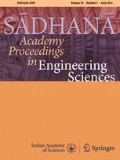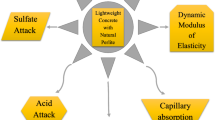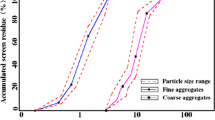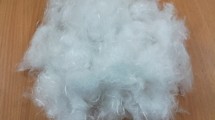Abstract
Polyester particles in concrete are preferred because they provide thermal, chemical and water resistance. In this study, thermal conductivity, electrical resistivity, mechanical strength and water resistance properties of concretes containing polyester granules such as flame-retardant polyester, cationic dyeable polyester and polyester with a low melting point-filled concrete have been analyzed using a full factorial design via Minitab® version 17. The effect of the most influential factors on thermal conductivity of polyester aggregate reinforced concrete composite has been determined as an interaction between the cationic dyeable and low-melt–point polyester. This mixture is suitable for production of thermal insulating concrete. Moreover, it is concluded that cationic dyeable polyester is the highest corrosion- and water-resistant product among the polyesters used in this study. The recovery rate of 33.94% in the thermal conductivity and 214.89% in the electrical resistivity of polyester-reinforced concrete composites has been obtained with a 28-day compressive strength loss of 41.94% according to the reference concrete in the full factorial design application. These results indicate that the polyester-reinforced concrete composites are quite effective in achieving thermal and corrosion resistance concrete but with noticeable compressive strength loss.





Similar content being viewed by others
References
Xu F, Zhou M, Chen J and Ruan S 2014 Mechanical performance evaluation of polyester fiber and SBR latex compound-modified cement concrete road overlay material. Constr. Build. Mater. 63: 142–149. https://doi.org/10.1016/j.conbuildmat.2014.04.054
Seleem H E H 2006 The effect of inorganic fillers on the mechanical and thermal properties of polyester. Polym. Plast. Technol. Eng. 45(5): 585–590. https://doi.org/10.1080/03602550600553754
Heidari-Rarani M, Aliha M R M, Shokrieh M M and Ayatollahi M R 2014 Mechanical durability of an optimized polymer concrete under various thermal cyclic loadings—An experimental study. Constr. Build. Mater. 64: 308–315. https://doi.org/10.1016/j.conbuildmat.2014.04.031
Zhao L, Guo X, Ge C, Li Q, Guo L, Shu X and Liu J 2016 Investigation of the effectiveness of PC@GO on the reinforcement for cement composites. Constr. Build. Mater. 113: 470–478. https://doi.org/10.1016/j.conbuildmat.2016.03.090
Martínez-Barrera G, Menchaca-Campos C and Gencel O 2013 Polyester polymer concrete: Effect of the marble particle sizes and high gamma radiation doses. Constr. Build. Mater. 41: 204–208. https://doi.org/10.1016/j.conbuildmat.2012.12.009
Rohatgi P K, Matsunaga T and Gupta N 2009 Compressive and ultrasonic properties of polyester/fly ash composites. J. Mater. Sci. 44(6): 1485. https://doi.org/10.1007/s10853-008-3165-1
Saribiyik M, Piskin A and Saribiyik A 2013 The effects of waste glass powder usage on polymer concrete properties. Constr. Build. Mater. 47: 840–844
Shokrieh M M, Rezvani S and Mosalmani R 2015 A novel polymer concrete made from fine silica sand and polyester. Mech. Compos. Mater. 51(5): 571–580. https://doi.org/10.1007/s11029-015-9528-1
Ribeiro M, Reis J, Ferreira A and Marques A 2003 Thermal expansion of epoxy and polyester polymer mortars—plain mortars and fibre-reinforced mortars. Polym. Test. 22(8): 849–857.
Ribeiro M, Tavares C and Ferreira A 2002 Chemical resistance of epoxy and polyester polymer concrete to acids and salts. J. Polym. Eng. 22(1): 27–44
Siddique R, Kapoor K, Kadri E H and Bennacer R 2012 Effect of polyester fibres on the compressive strength and abrasion resistance of HVFA concrete. Constr. Build. Mater. 29: 270–278. https://doi.org/10.1016/j.conbuildmat.2011.09.011
Abu-Jdayil B, Mourad A H and Hussain A 2016 Thermal and physical characteristics of polyester–scrap tire composites. Constr. Build. Mater. 105: 472–479. https://doi.org/10.1016/j.conbuildmat.2015.12.180
Nabinejad O, Sujan D, Rahman M E and Davies I J 2015 Effect of oil palm shell powder on the mechanical performance and thermal stability of polyester composites. Mater. Des. 65: 823–830. https://doi.org/10.1016/j.matdes.2014.09.080
Jamshidi M and Pourkhorshidi A R 2012 Modified polyester resins as an effective binder for polymer concretes. Mater. Struct. 45(4): 521–527. https://doi.org/10.1617/s11527-011-9779-9
Adeosun S O, Gbenebor O P, Akpan E I and Udeme F A 2016 Influence of organic fillers on physicochemical and mechanical properties of unsaturated polyester composites. Arabian J. Sci. Eng. 41(10): 4153–4159. https://doi.org/10.1007/s13369-016-2120-8
Wang B, Qian T, Zhang Q, Zhan X and Chen F 2016 Heat resistance and surface properties of polyester resin modified with fluorosilicone. Surf. Coat. Technol. 304: 31–39. https://doi.org/10.1016/j.surfcoat.2016.06.075
Lin J H, Hsieh J C, Lin J Y, Lin M C and Lou C W 2014 Polyester/low melting point polyester nonwoven fabrics used as soilless culture mediums: effects of the content of low melting point polyester fibers. In: Applied Mechanics and Materials 2014, pp. 49–52. Trans Tech Publ 10.4028/ https://doi.org/10.4028/www.scientific.net/AMM.457-458.49
Carosio F, Di Blasio A, Cuttica F, Alongi J and Malucelli G 2014 Flame retardancy of polyester and polyester–cotton blends treated with caseins. Ind. Eng. Chem. Res. 53(10): 3917–3923
Zhao M L, Li F X, Yu J Y and Wang X L 2014 Preparation and characterization of poly (ethylene terephthalate) copolyesters modified with sodium-5-sulfo-bis-(hydroxyethyl)-isophthalate and poly (ethylene glycol). J. Appl. Polym. Sci. 131(3): 39823
TS EN ISO 1183-1 2015 Plastics—Methods for determining the density of non-cellular plastics—Part 1: Immersion method, liquid pyknometer method and titration method. p. 22.
TS EN ISO 527-1 2015 Plastics—Determination of tensile properties—Part 1: General principles. p. 33
Bounouri Y, Berkani M, Zamouche A and Rycerz L 2017 Optimization and modeling of synthesis parameters of neodymium(III) bromide by dry method using full factorial design analysis. Arabian J. Chem. https://doi.org/10.1016/j.arabjc.2017.05.003
Cintas P G, Almagro L M and Llabrés X T M 2012 Pareto charts and cause–effect diagrams. In: Industrial Statistics with Minitab. Wiley, pp. 31–36
Şimşek B and Uygunoğlu T 2016 Multi-response optimization of polymer blended concrete: A TOPSIS based Taguchi application. Constr. Build. Mater. 117: 251–262. https://doi.org/10.1016/j.conbuildmat.2016.05.027
Huang J, Lv H, Gao T, Feng W, Chen Y and Zhou T 2014 Thermal properties optimization of envelope in energy-saving renovation of existing public buildings. Energy Build. 75: 504–510. https://doi.org/10.1016/j.enbuild.2014.02.040
ASTM C1113/C1113M-09 2013 Standard test method for thermal conductivity of refractories by hot wire (Platinum Resistance Thermometer Technique) (American Society for Testing and Materials, West Conshohocken, PA)
Wang H, Yang J, Liao H and Chen X 2016 Electrical and mechanical properties of asphalt concrete containing conductive fibers and fillers. Constr. Build. Mater. 122: 184–190. https://doi.org/10.1016/j.conbuildmat.2016.06.063
Lübeck A, Gastaldini A L G, Barin D S and Siqueira H C 2012 Compressive strength and electrical properties of concrete with white Portland cement and blast-furnace slag. Cem. Concr. Compos. 34(3): 392–399. https://doi.org/10.1016/j.cemconcomp.2011.11.017
TS EN 2010 Testing Hardened Concrete—Part 3, Compressive Strength of Test Specimens. p. 21. Ankara
TS EN 2010 Testing Hardened Concrete—Part 6, Determination of Splitting Tensile Strength of Concrete Specimens. p. 13. Ankara
TS EN 2010 Testing fresh concrete-Part 5, Flow table test. p. 9. Ankara
TS EN 12390 2010 Testing Hardened Concrete—Part 7, Density of Hardened Concrete, p. 12. Ankara.
Şimşek B, İç Y T and Şimşek E H 2016 A RSM-based multi-response optimization application for determining optimal mix proportions of standard ready-mixed concrete. Arabian J. Sci. Eng. 41(4): 1435–1450. https://doi.org/10.1007/s13369-015-1987-0
Marzouk O Y, Dheilly R M and Queneudec M 2007 Valorization of post-consumer waste plastic in cementitious concrete composites. Waste Manage. 27(2): 310–318. https://doi.org/10.1016/j.wasman.2006.03.012
Gu L and Ozbakkaloglu T 2016 Use of recycled plastics in concrete: a critical review. Waste Manage. 51: 19–42. https://doi.org/10.1016/j.wasman.2016.03.005
Fraj A B, Kismi M and Mounanga P 2010 Valorization of coarse rigid polyurethane foam waste in lightweight aggregate concrete. Constr. Build. Mater. 24(6): 1069–1077
Goñi S, Frias M, Vegas I, García R and de la Villa R V 2012 Quantitative correlations among textural characteristics of C–S–H gel and mechanical properties: case of ternary Portland cements containing activated paper sludge and fly ash. Cem. Concr. Compos. 34(8): 911–916. https://doi.org/10.1016/j.cemconcomp.2012.05.002
Author information
Authors and Affiliations
Corresponding author
Rights and permissions
About this article
Cite this article
Şimşek, B., Uygunoğlu, T. Thermal, electrical, mechanical and fluidity properties of polyester-reinforced concrete composites. Sādhanā 43, 57 (2018). https://doi.org/10.1007/s12046-018-0847-5
Received:
Revised:
Accepted:
Published:
DOI: https://doi.org/10.1007/s12046-018-0847-5




